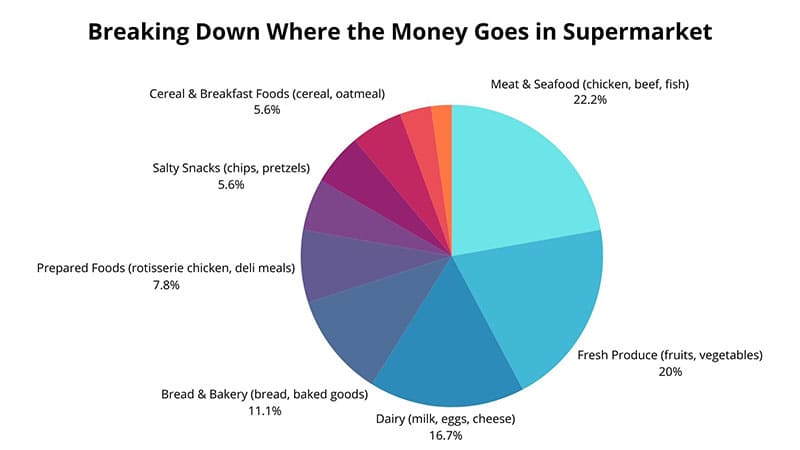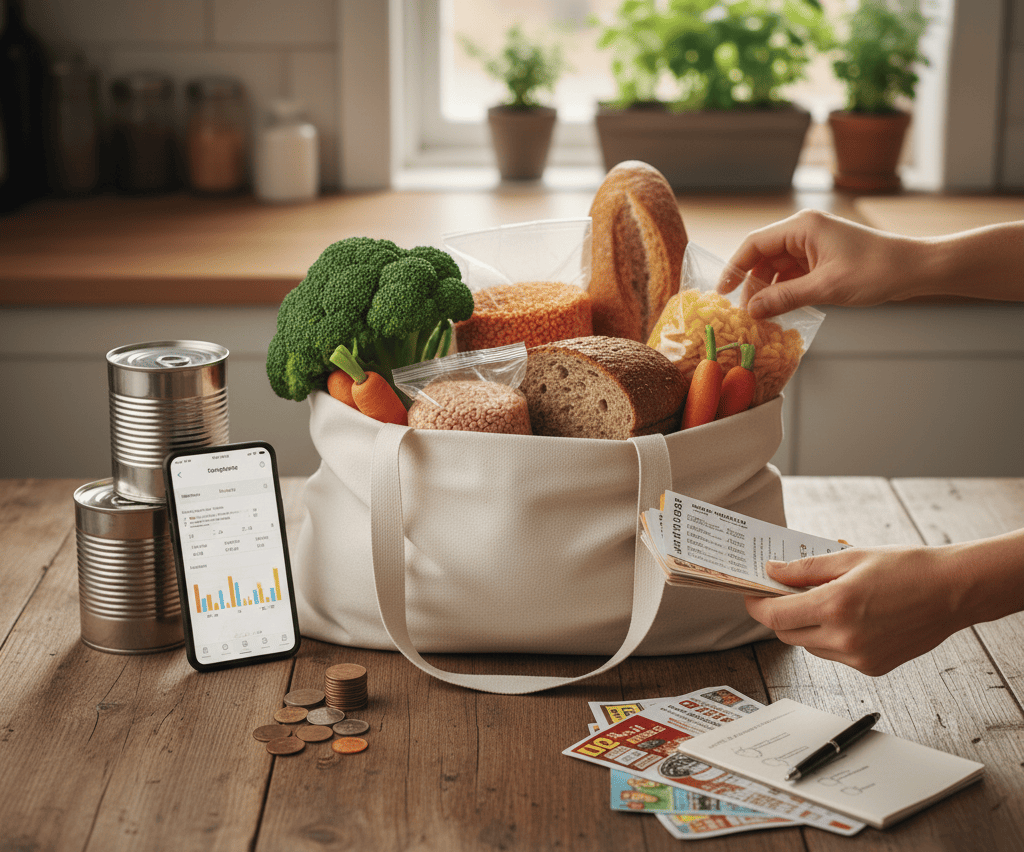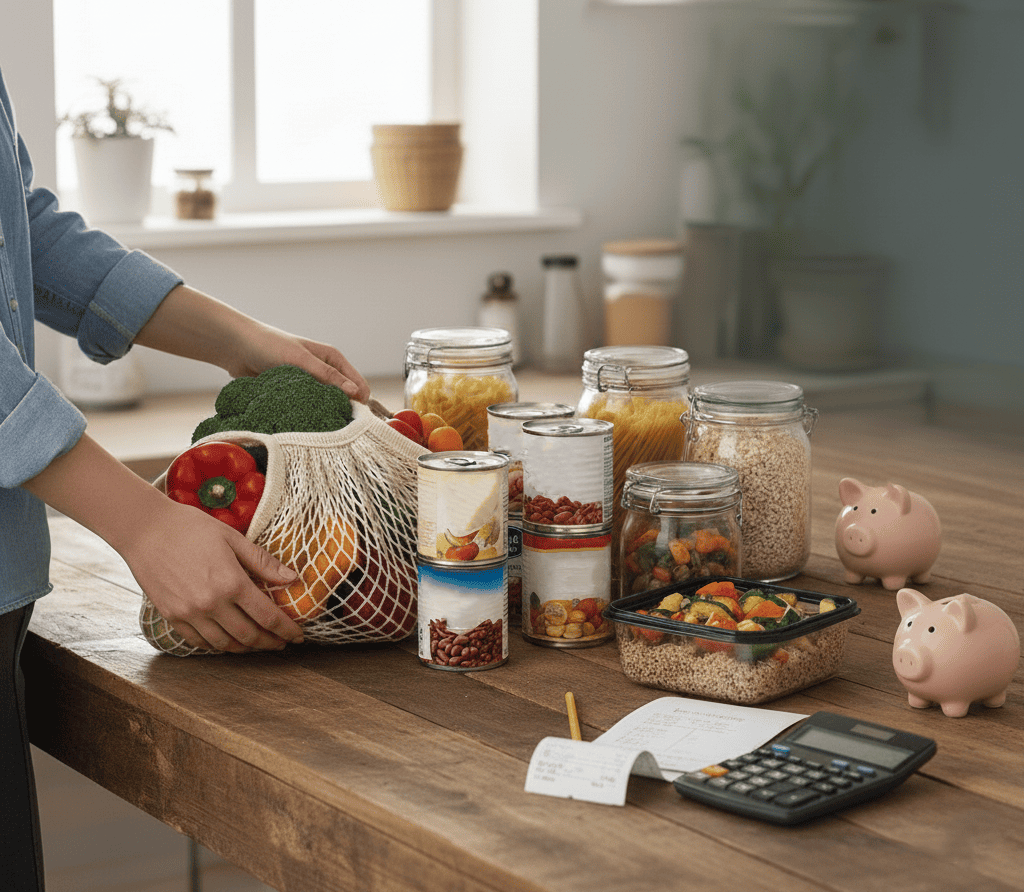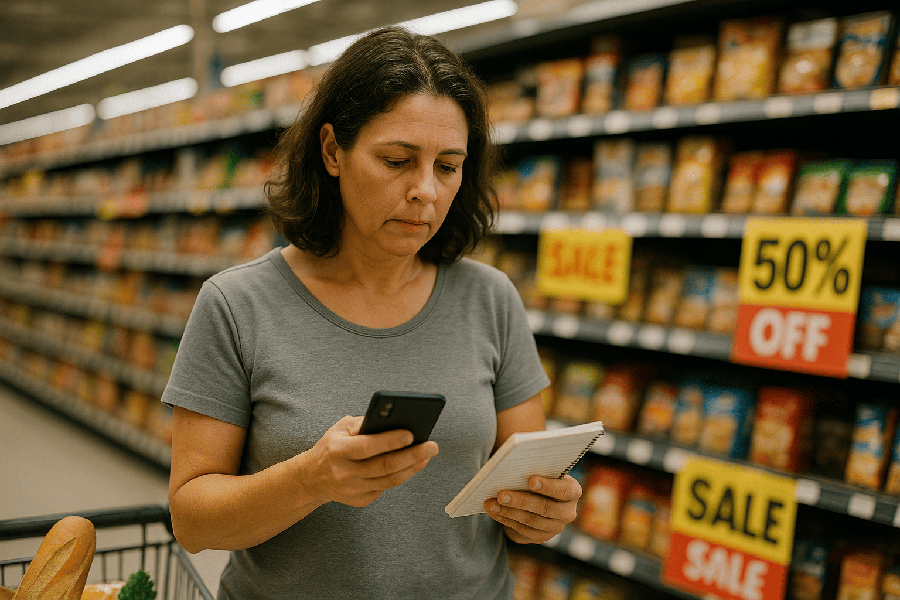Quick Quiz:
Answer step by step. Your result will appear at the end.
Food prices in 2025 remain volatile. Between shrinkflation, higher transport costs, and premium packaging, the same basket quietly costs more while holding less. For many households, groceries are now the most variable line item after housing - swinging by $50-$150 month to month - so small missteps compound quickly. The good news: you can regain control with a clear playbook that targets the biggest drivers of overspending, not your nutrition or enjoyment.
If you've wondered how to food shop on a budget, think systems, not one-off hacks. The shoppers who consistently win do three things: plan meals around predictable discounts, compare unit prices instead of headline tags, and reduce waste by cooking what they buy. Add a few behavior shifts - shopping after a meal, rotating proteins, embracing frozen produce - and the results are measurable in the very next receipt. This guide pulls together professional tactics, practical tools, and real-life stories to help you lower costs without lowering standards.
Listen to the article - it is faster than reading!
Breaking Down Where the Money Goes
Most households overspend on groceries not because they buy luxury items but because their biggest recurring categories are left unchecked. A small shift in behavior within these categories has a massive effect on the monthly bill.
According to U.S. data, just ten food categories absorb the majority of grocery spending, and within them, five alone account for roughly 70% of the average family's budget.
Knowing this breakdown is critical if you want to understand how to save money on food shopping effectively. It's not about skipping treats entirely - it's about focusing your strategies where the money actually goes.

Here's how the top categories stack up:
-
Meat & Seafood (chicken, beef, fish)
This category is the single largest driver of household food budgets. Prices swing heavily, but savings are possible with family-size packs, frozen bulk buys, and versatile cuts like chicken thighs. Seafood tends to command premium prices - using tinned fish or rotating in plant-based proteins stabilizes costs. -
Fresh Produce (fruits, vegetables)
Produce is a high-spend but also high-impact category. Costs spike when shoppers lean on out-of-season or pre-cut options. Sticking with seasonal fruits and vegetables or frozen produce keeps nutrition high and prices lower. -
Dairy (milk, eggs, cheese)
Staples like milk, cheese, and eggs appear on nearly every shopping trip. Households can control costs here by purchasing store brands, buying in larger formats, and using sales for stock-up. Eggs in particular remain one of the cheapest protein sources per serving. -
Bread & Bakery (bread, baked goods)
Bread and baked goods are daily-use staples, but frequent small trips and premium branding inflate spending. Freezing bread, opting for bulk rolls, or baking occasionally at home reduces waste and lowers costs. -
Prepared Foods (rotisserie chicken, deli meals, baked goods)
Prepared items are convenient but costly. A rotisserie chicken often equals the cost of raw ingredients for several meals. Using prepared foods strategically - only on hectic days - keeps the benefit without draining the budget. -
Salty Snacks (chips, pretzels)
Salty snacks are frequent impulse buys, and their price per calorie is high compared to staples. Setting limits, buying family-size packs, or replacing with DIY popcorn helps keep this spend predictable. -
Cereal & Breakfast Foods (cereal, oatmeal)
Breakfast foods are heavily marketed but vary in value. Bulk oats provide nutrition at a fraction of boxed cereal's cost. Cereal on sale with coupons can still be economical when managed. -
Soda & Soft Drinks
Non-alcoholic beverages are among the most wasteful spends per nutrition dollar. Reducing soda purchases or substituting with flavored water drops recurring costs quickly. -
Frozen Foods (frozen meals, vegetables)
Frozen items balance convenience and waste reduction. Frozen vegetables often cost less than fresh out-of-season produce. Frozen ready meals, however, carry a high markup compared to cooking from raw ingredients. -
Pet Food (dog food, cat food)
While not “human food,” pet food still takes a consistent slice of household grocery budgets. Savings come from bulk buying, store brands, or subscription services for recurring deliveries.
6 Practical Tactics to Save Money on Supermarket Shopping
Saving on groceries is a system: plan with a calendar, choose by unit price, and cook to your inventory - not your cravings. The shoppers who reliably spend less put friction between impulses and the cart. They plan meals around store apps and weekly ads, write precise lists, and enter the store already knowing what wins on value this week. They also eat before shopping, compare brands by price per ounce, and schedule one “clear-the-fridge” meal to capture leftovers. Finally, they time trips near closing for markdowns and buy perimeter staples in store to avoid markups. Stack these moves and you'll see a real, compounding drop in monthly spend.
Make a Detailed List - and Stick to It
(est. monthly savings: $30-$45)
A precise list eliminates duplicate pantry buys and “just in case” items that die in the crisper. Build it from a weekly menu and your pantry log: proteins, produce, grains, snacks, and household staples. Group by aisle to reduce browsing time (and temptations). If an unplanned item tempts you, park it in the cart's child seat and decide at checkout - nine times out of ten, it goes back. Capture recurring essentials in your notes app or a list tool so you don't re-decide every week. This single discipline trims 10-15% by cutting impulse spend and food waste. (Pro tip: photograph your fridge/freezer shelves before leaving; buy to fill gaps, not whims.)
Plan Meals Around Weekly Sales & Store Apps
(est. monthly savings: $45-$70)
Check circulars and digital coupons before you plan meals, not after. Let the week's loss leaders dictate the menu: if chicken thighs and broccoli are discounted, think stir-fry, sheet pan dinners, or soups. Clip digital offers, then build a cart that stacks savings (sale price + coupon + loyalty). Schedule protein-heavy recipes early in the week and repurpose leftovers midweek (tacos, grain bowls). Keep two “flex recipes” that adapt to whatever produce is cheapest. This planning flow converts marketing into your advantage and stabilizes spend even when prices swing.
Eat Before You Shop
(est. monthly savings: $10-$20)
Hunger hijacks decisions. A small snack pre-trip slashes snack aisle leakage and “treats” at checkout. Set a time limit (e.g., 30 minutes) to reduce wandering; stick to your mapped aisles. If you bring kids, pre-agree on one treat within a budget cap and avoid endcaps designed to spike dopamine. The savings are small per trip but consistent across the month - often the difference between meeting or missing your target.
Compare Unit Prices & Favor Store Brands
(est. monthly savings: $30-$60)
Headline tags mislead; unit prices tell the truth. Train your eye to “¢/oz” or “$/lb,” especially for cereals, snacks, dairy, and cleaning supplies. Many store brands come from the same co-packers as national brands; taste test once, then default to the cheaper equivalent. When people ask how to save money food shopping, the honest answer is: buy quality at the lowest unit cost, not the loudest label. For staples, step down one brand tier; for items with meaningful quality differences (e.g., coffee), hunt sales and buy in bulk.
Cook Your Inventory: “Clean-Out-the-Fridge” Meals
(est. monthly savings: $25-$40)
Waste is the stealth tax on your budget. Once a week, build dinners from what's already open: frittatas for extra veg and cheese, fried rice for leftover grains and protein, soups for limp produce. Keep a “needs about to expire” bin in the fridge. Freeze odds and ends (tomato paste, herbs, stock) in ice cube trays. This routine alone can reclaim $300-$500 per year by converting would-be waste into planned meals.
Time Your Trip & Target Markdowns
(est. monthly savings: $20-$35)
Arrive near closing for bakery, meat, and produce markdowns; many stores discount perishables 20-50% late day. Buy perimeter staples (produce, eggs, meat) in store to secure the best unit prices and freshness, and use delivery primarily for dry goods when fees are offset by coupons. Keep a “markdown playbook”: stir-fry kits for discounted veg, chili for near-date ground meat, bread for freezing. The point isn't chasing bargains - it's structuring your timing so value comes to you.
We are recommend
Smart Monthly Savings Calculator
Want to know if your savings plan is realistic? Our Smart Savings Calculator shows how much you can set aside each month, how close you are to reaching your goal, and what small changes could accelerate your progress. Built by our financial expert Henry Trent, it explains results in plain language, offers practical tips, and keeps all data private on your device. Try it now and see your financial path with clarity.
How to Shop for Healthy Food on a Budget?
Healthy eating on a budget is not about restriction, but about choosing foods that deliver the maximum nutrients per dollar. By focusing on versatile, long-lasting, and nutrient-dense staples, you can build balanced meals without overspending. Here's how:
-
Build Around Legumes and Eggs
Legumes such as beans, lentils, and chickpeas are nutritional powerhouses. They provide plant-based protein, complex carbohydrates, and fiber, all at a fraction of the cost of meat. A pound of dried beans costs around $1-$2 and yields up to 6-7 cups of cooked product - enough for multiple meals. Lentils cook faster than most beans, making them ideal for quick soups, curries, or salads. Eggs add affordable protein and healthy fats, costing about $2-$3 per dozen in many U.S. regions. When combined, beans and eggs deliver complete amino acids, supporting muscle and energy without draining the budget. Think bean chili topped with a fried egg, or grain salads with boiled eggs for portable lunches. -
Choose Frozen Produce Strategically.
Frozen vegetables and fruits are picked and flash-frozen at peak ripeness, preserving their vitamins and minerals. Compared to out-of-season fresh produce, frozen options can be 20-40% cheaper per pound. For example, fresh blueberries might cost $5 for a small container in winter, while a large bag of frozen berries costs $10 but lasts for weeks and yields dozens of servings. Frozen spinach, broccoli, peas, and mixed vegetable blends are perfect for stir-fries, smoothies, and soups. They reduce food waste because you can take only what you need and store the rest. For families, buying two or three frozen staples ensures you always have nutrient-rich options at home without making emergency trips to the store. -
Buy Whole Grains in Bulk
Whole grains like oats, brown rice, and quinoa are the foundation of budget-friendly, nutrient-rich meals. Buying them in bulk bins or large family-sized packages significantly reduces the cost per serving. For instance, a 25-pound bag of brown rice can cost as little as $15-$20 and provide months of meals. Oats are another affordable powerhouse - rolled oats can cost just a few cents per serving and form the base for breakfasts, snacks, or baking. Store grains in airtight containers in a cool, dry place to prevent spoilage and pests. Grains are versatile and pair well with beans, vegetables, and proteins, so you can build dozens of different meals while maintaining nutritional balance. -
Make DIY Snacks
Pre-packaged snacks are one of the biggest drains on grocery budgets. Single-serving yogurt cups, snack bars, and pre-cut fruit often cost two to three times more than the same ingredients purchased separately. By preparing snacks at home, you avoid this markup and gain control over sugar and sodium content. For example, instead of buying individual yogurt parfaits for $2-$3 each, buy a large tub of plain yogurt ($5), a bag of oats or granola ($3-$4), and a bag of frozen berries ($10). Together, they provide 10-12 servings of healthy snacks for less than $1 each. Other budget-friendly DIY snacks include roasted chickpeas, homemade trail mix, or hummus with carrot sticks. This habit saves $20-$40 per month for many households. -
Flavor with Pantry Staples
One reason people abandon budget meal plans is boredom. Pantry staples like olive oil, vinegar, soy sauce, garlic, citrus, and spices transform simple ingredients into flavorful meals. A $2 bag of dried beans becomes rich chili with cumin, paprika, and tomato paste. Frozen broccoli tastes restaurant-worthy when sautéed in garlic and olive oil. Pantry staples are also long-lasting, making them a cost-effective investment. A $5 jar of curry powder or a $3 bottle of soy sauce can flavor dozens of meals, reducing the urge to order takeout. By mastering seasoning, you ensure your low-cost meals are satisfying and varied, helping you stick to your budget long term.
Checklist: Fast Wins You Can Lock In This Week
Most households overspend because their routine is fuzzy. Tighten the loop: decide once, repeat often. Use a repeatable list, eat before shopping, and pick one discounted protein and two seasonal produce items to anchor the week. Schedule one “clear-the-fridge” dinner and one pantry-only meal. Track spend in a simple note divided by categories (protein, produce, staples, snacks, household).
This checklist can be copied and applied today. Start with just three actions - make a list, plan around two weekly sales, and cook one inventory meal - and you'll feel the difference on your next receipt.
Real-Life Budget Shopping Stories
Top-7 Digital Tools That Help You to Save Money on Food Shopping
Shoppers win when information shows up before temptation. In 2025, the best apps surface sales, automate price comparisons, track pantry stock, and turn receipts into cash-back. They also help families coordinate lists and avoid duplicate runs.
The goal isn't to chase every deal; it's to point your existing routine toward consistent value.
Use one tool to plan (ads/coupons), one to track (lists/pantry), and one to capture rebates. Set weekly reminders and keep everything synced across the household. Below are seven trustworthy tools, each strong in a specific job.
| Tool | How It Helps (expert detail) |
| Flipp | Flipp aggregates weekly circulars and digital coupons for thousands of stores, letting you compare prices side-by-side and build a list tied to actual deals. The value is strategic: check Flipp before planning meals, then let the week's loss leaders decide proteins and produce. Clip coupons in-app, organize by store, and share a list with family members so everyone buys to plan. Flipp also highlights “must-clip” offers - stackable with loyalty - so you don't miss high-ROI discounts. Used consistently, it shifts you from reactive shopping to a sale-first mindset, shaving $20-$40/month for typical families. |
| Ibotta | Ibotta turns receipts into cash-back across supermarkets and major online retailers. Link loyalty accounts where possible for automatic redemption; otherwise, snap a receipt and select qualifying offers. The trick is to pre-select rebates aligned with your list, not the other way around. Ibotta regularly features staples (eggs, milk, pasta) and bonus streaks that multiply payouts. Families who pair Ibotta with store apps commonly recoup $10-$25/month. Think of it as a passive layer of savings rather than a reason to buy more. |
| Checkout 51 | Checkout 51 provides weekly cash-back offers with simple receipt scans - useful if your store doesn't integrate deeply with other apps. Offers often target produce and household items, filling gaps left by other programs. Check on Wednesday/Thursday when new deals drop, and align with your Flipp-built plan. Redemptions accumulate toward threshold payouts (e.g., $20), making it a steady background saver. For shoppers who want a low-friction rebate tool, Checkout 51 is a reliable complement. |
| Instacart | Beyond delivery, Instacart is a powerful comparison engine: browse multiple local stores, filter by unit price, and sort by promotions. If delivery fees threaten savings, use pickup or leverage credit-card promos and store-specific coupons inside the app. Instacart is especially effective for “planned carts” built from your weekly menu - zero aisle temptations, clear totals, and instant substitutions for out-of-stocks. Families use it to standardize budgets and time, not just to outsource the trip. |
| Out of Milk | This list and pantry tracker keeps you from buying duplicates and forgetting essentials. Create shared, categorized lists (produce, dairy, bulk) and maintain a simple pantry inventory (counts + best-by dates). Before you plan, check what you own; before you shop, the app tells you what's low. Over time, Out of Milk becomes your household's memory - reducing waste, emergency top-ups, and impulse buys. The payoff is fewer trips and tighter carts. |
| Your Grocery Store's Official App (e.g., Kroger, Walmart, Target) | Store apps are the most underused savings engine. They combine digital coupons, personalized offers, fuel points, and in-store pricing. Clip coupons to your card, scan barcodes for instant unit-price comparisons, and build a cart that auto-applies discounts. Many chains run targeted “buy X, save Y” promos you only see in the app. Used weekly, these apps are the difference between paying shelf price and capturing the intended value of the store's ecosystem. |
| Buy Me a Pie! | A minimalist, shareable list app that organizes by aisle or recipe - perfect for multi-person households. Color-coded categories keep trips efficient, and real-time sync prevents duplicate purchases. Because it keeps the list experience frictionless, families stick to it - reducing in-store decision fatigue and impulse spend. Over months, that discipline compounds into serious savings. |
FAQ: Smart Answers to Common Questions About Food Shopping on a Budget
How to grocery shop for healthy food on a budget?
Start with nutrient density per dollar. Build meals around legumes, eggs, tinned fish, and whole grains; layer in seasonal produce and frozen veg for consistency. Shop with a weekly plan shaped by store apps and circulars. Use unit prices to choose value (¢/oz), and buy larger formats you can portion and freeze. Make DIY snacks (yogurt + oats, hummus + veg) to replace premium single-serves. Keep a “use first” bin in the fridge for near-date items. With this pattern, you'll hit protein, fiber, and micronutrients while keeping receipts predictable.
How to survive on $100 a month for food?
Constrain choice and standardize meals. Choose 6-8 staple recipes using cheap proteins (beans, eggs), bulk grains (oats, rice), and frozen veg. Buy store brands, track unit prices, and cook in batches for leftovers. Skip beverages beyond water/tea; redirect dollars to calories and nutrients. Use Flipp/Ibotta for weekly loss leaders and rebates. A typical month: oatmeal + peanut butter breakfasts; rice/bean bowls with eggs and salsa; soups and lentil stews; pasta + veg + oil/garlic. It's tight, but disciplined planning and zero waste make it feasible.
What is the 3-3-3 rule for groceries?
Use three proteins, three vegetables/fruits, and three starches per week to keep costs and decisions under control. Example: proteins - eggs, chicken thighs, black beans; veg/fruit - broccoli, carrots, apples; starches - rice, oats, potatoes. Plan all meals from these nine inputs, rotate sauces/spices for variety, and buy in formats with the best unit prices. This constraint ensures you finish what you purchase, minimize waste, and simplify prep - while leaving room to swap in weekly sale items.
How to grocery shop on a budget for 3 persons?
Set a weekly cap and divide it: e.g., $120/week → $40 proteins, $35 produce, $25 staples, $10 dairy, $10 snacks/household. Plan five dinners and two flex meals for leftovers/markdowns. Choose one discounted protein and stretch it across two dishes. Use a shared list app, batch-cook once, and pack two lunches per person from leftovers. Compare unit prices; default to store brands; buy fruit in bulk and portion for snacks. This structure keeps spend stable while feeding three well.
How do I avoid overspending with coupons?
Reverse the sequence. Plan meals first, then clip coupons that fit - not the other way around. Use store apps to stack sales + digital coupons + loyalty, and ignore offers for items you don't need. Track your “coupon ROI” monthly: total saved vs. extra spend. If a coupon pushes you into pricier brands after discounts, skip it. The goal is alignment, not accumulation.
What are the healthiest foods to buy on a budget?
Focus on oats, brown rice, eggs, beans/lentils, frozen veg, in-season fruit, plain yogurt, canned tomatoes, and tinned fish. They're nutrient-dense, versatile, and cheap per serving. Combine them with pantry flavor anchors (olive oil, spices, vinegar) to avoid monotony. Buy by unit price, store properly (airtight containers, freezer portions), and repurpose leftovers into soups, bowls, and bakes. Healthy on a budget is about patterns: simple building blocks, cooked often.






